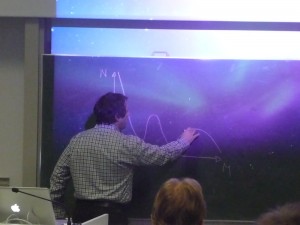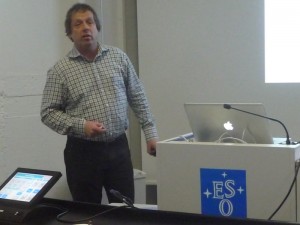Willi Benz talks about extra-solar planets at ESO

Science Day at ESO
February 25, 2010
Strong earthquake hits Chile
March 1, 2010Every week, on Thursday afternoons, ESO hosts the Munich Joint Astronomy Colloquium. This is organized by all the astronomical institutes in the Munich area (there are quite a few). The idea is to invite leading scientists to give an overview on a specific field of astrophysics. Yesterday it was the turn of Willy Benz, professor at the University of Bern. Willy is an expert in numerical simulations. I remember the first time I met him, at a NATO school in Spain, back in 1995. At that time he was doing Smoothed Particle Hydrodynamics (SPH for short) simulations of supernova explosions. However, if you look at his publications, you will see that he has done lots of work in the planet formation field, where he has applied his hydrodynamical models to study the accretion of planetesimals, impacts, crater formation and stuff like that. And, in fact, the title of yesterday’s talk was “What have exoplanets told us about planet formation?”.

Willy Benz explaining the Neptune-Peak. In the plot you can see the broad Jupiter-Peak (which Willy is indicating), the Neptune-Peak (in the middle) and the Earth-like peak (to the left).
As expected, given the appealing subject, the auditorium was full. Willy has started giving an introduction on the planet formation basics, as we understand them now. He started off saying that for many, many years, before the discoveries of exo-planets, it was believed that big planets (Jupiter-like) do not form close to their central star. Joking, Willy said this was based on many, many years of observations and studies on one single case (our Solar system). As it often happens in science, the first exoplanet, which was discovered in 1995 by Michel Mayor and Didier Queloz using ESO telescopes, destroyed this castle of ideas in one single shot. “This is one of those cases” – said Willy – “where one observation is sufficient to blow up a theory“. Since then, more than 400 exo-planets have been found, and the vast majority of them populates what was believed to be a forbidden region. Part of this is certainly due to an observational bias, in the sense that with the current instrumentation it is easier to discover massive planets that move fast (i.e. are very close to the central star. This is why they are also called hot-Jupiters).
What Willy and his collaborators have done, is to produce with hydro simulations synthetic populations of planets, and compare them to observations. The experimental data we have for each single exo-planet does not tell us very much in itself. The real power comes from statistics: that is the place where theoretical models and observations can be compared. “The discovery of the whole population of exoplanets is essential to provide important constraints on planet formation models” – said Willy. Although the planet formation field is still driven by observations, theory is starting to make some quantitative predictions. “If you believe the models (which you probably shouldn’t) – joked Benz – “we expect to see the Neptun-Peak coming up and, in the future, the big peak of Earth-like planets“. In fact, their models predict that the number of planets having characteristics similar to our Neptune (10 AU distance from the central star and Neptune mass) should be rater large (there the name of Neptune-Peak). From the observational point of view, unveiling this kind of planets requires a very high precision. Now we can measure velocities up to about 1 meter per second accuracy, with instruments like HARPS. In the future, we will be able to go down to 10 cm per second. The new high resolution spectrograph ESPRESSO is designed exactly for that purpose. This will allow us to detect planets well below the 10 Earth masses limit, and give us the opportunity to see whether, indeed, Earth-like planets are rare or not.
What I liked in Willy’s talk, besides of course the underlying physical robustness of his science, is his way of presenting things, always cum grano salis and within a wide astrophysical context, not too detailed but also not too generic.
Great speaker, great talk, great science.



1 Comment
I have visited this site and got lots of information than other site visited before a month.
work and study